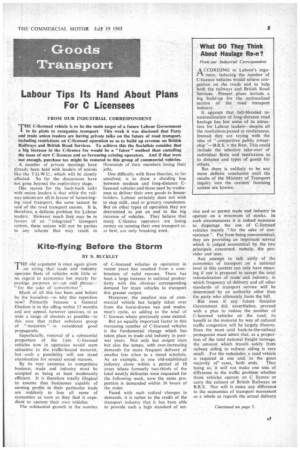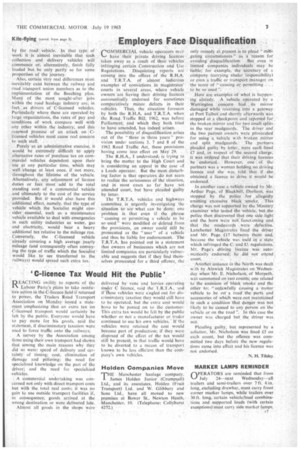Kite-flying Before the Storm
Page 7

Page 9

If you've noticed an error in this article please click here to report it so we can fix it.
BY S. BUCXLEY
THE old argument is once again given
an airing that trade and• industry operates fleets of vehicles with little or no regard to economics but merely for prestige purposes or—an odd phrase-"for the sake of convenience".
Much of all this has been said before by the Socialists—so why this repetition now? Primarily because a General Election is in the offing within 15 months and any appeal, however specious, to as wide a range of electors as possible—in this case that rather nebulous group of "motorists "--is considered good propaganda.
Superficially, removal of a substantial proportion of the lfm. C-licensed vehicles now in operation would seem attractive to the traffic-bound motorist, but such a possibility will not stand examination for several sound reasons.
By its very existence in competitive business, trade and industry must be accepted as being at least moderately efficient. It is therefore totally illogical to assume that businesses capable of earning profits in their particular trade are suddenly to lose all sense of economics as soon as they find it expedient to operate their own vehicles.
The substantial growth in the number of C-licensed vehicles in operation in recent years has resulted from a combination of valid reasons. There has been a large increase in national productivity with the obvious corresponding demand for more vehicles to transport this greater output.
Moreover, the smallest size of commercial vehicle has largely taken over from the horse-drawn van and tradesman's cycle, so adding to the total of C licences where previously none existed.
But an equally important factor in this increasing number of C-licensed vehicles is the fundamental change which has taken place in trade and industry in postwar years. Not only has output risen but also the tempo, with ever-increasing demands for more frequent delivery of smaller lots often to a timed schedule. As an example. in one old-established industry alone within a period of 10 years where formerly two-thirds of the total weekly deliveries were requested for the following week, now the same proportion is demanded within 36 hours of the order.
Faced with such radical changes in demands, it is rather to the credit of the transport industry that it has been able to provide such a high standard of ser vice and so permit trade and industry to operate • on a minimum of stocks. In such circumstances it is indeed nonsense to disparage the use of C-licensed vehicles merely "for the sake of convenience ". Far from being uneconomical, they are providing an important service which is judged economical by the two principals concerned, namely, the provider and user.
Any attempt to talk airily of the economics of transport on a national level in this context can only have meaning if one is prepared to accept the total rationalization of trade and industry, in which frequency of delivery and all other standards of transport service will be determined by an authority other than the party who ultimately foots the bill.
But even if any future Socialist Government did, nevertheless, proceed with a plan to reduce the number of C-licensed vehicles on the road, its benefit to the motorist by way of reduced traffic congestion will he largely illusory. Even the most avid back-to-the-railway protagonist must admit that, as a proportion of the total national freight tonnage, the amount which travels solely from railway siding to railway siding is very small. For the remainder, a road vehicle is required at one and, in the great
majority of' cases, both ends. That being so, it will not make one iota of difference to the traffic problem whether those vehicles operate on C licence or carry the colours of British Railways or B.R.S. Nor will it make any difference to the economics of transport movement as a whole as regards the actual delivery by the road vehicle. In that type; of work it is almost inevitable that sUch collection and delivery vehicles will commence or, alternatively, finish fully loaded but be only partly so for some proportion of the journey.
• Also,. certain very, real differences niust inevitably exist between the railway and road transport union members as to the implementation of the Beeching plan. Many. of the most sought-after jobs within the road haulage industry are, in fact,as drivers of C-licensed vehicles. Particularly where these are operated' by large organizations, the rates of pay and
• conditions of work compare well with any other within the industry, and this renewed promise of an attack on Clicenaed vehicles must cause real concern to such staff.
Purely as an administrative exercise, it would be extremely difficult to apply alternative rates of purchase tax on commercial vehicles dependent upon their use at any particular time, which may well Change at least once, if not more, throughout the lifetime of the vehicle. Alternatively, any adjustment of licence duties or fees most add to the total standing cost of a commercial vehicle and ultimately to the cost of the service provided. But itwould also have this additional effect, namely, that the type of vehicle which the Socialist might consider essential, such as a maintenance vehicle available to deal with emergencies in such utility industries as water, gas and electricity, would bear a heavy additional tax relative to the mileage run. Conversely, the C-licensed vehicle already covering a high average . yearly mileage (and consequently -often conveying the type of traffic which the Socialist would like to see transferred to the railways) would spread such extra tax.




















































































































